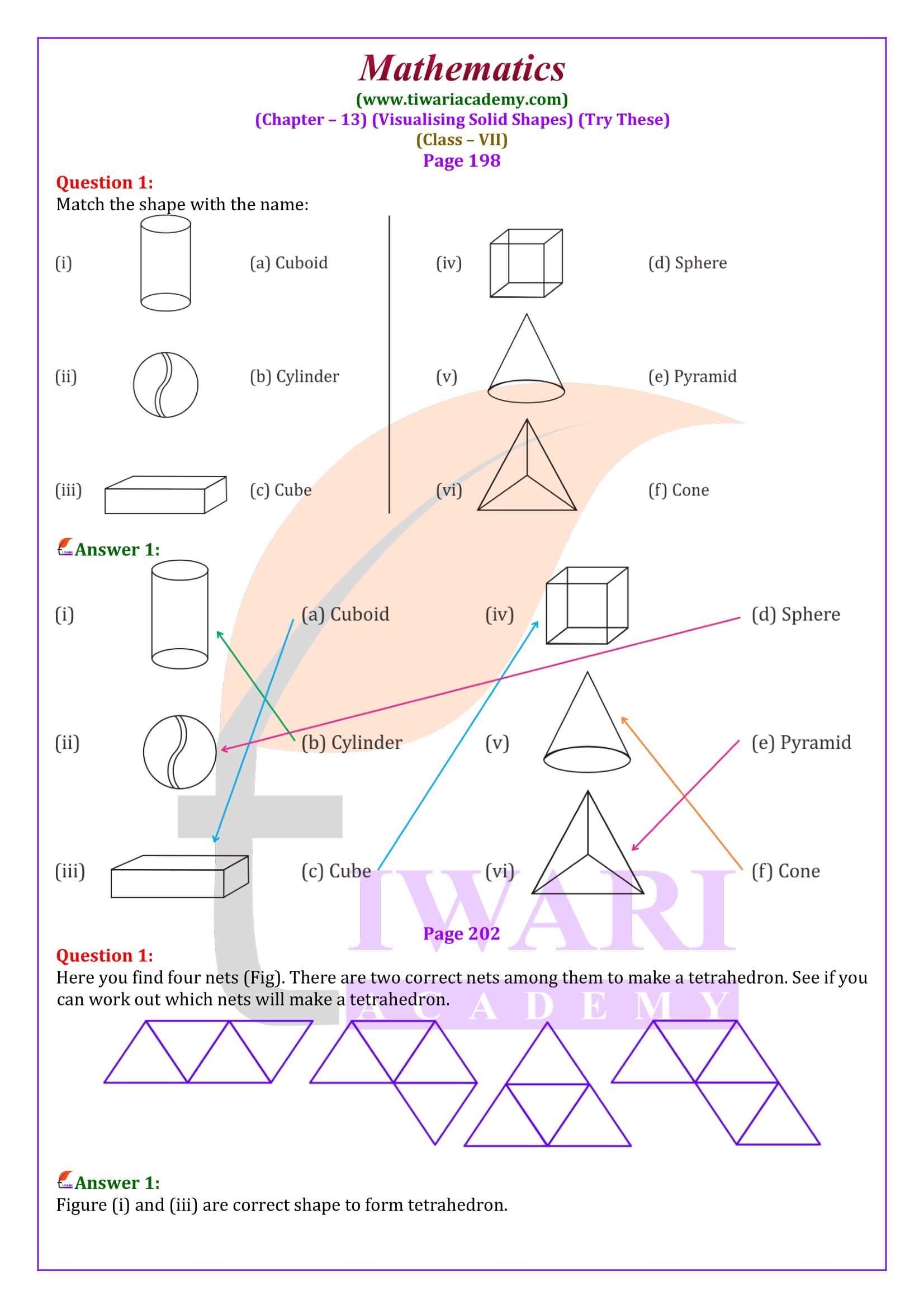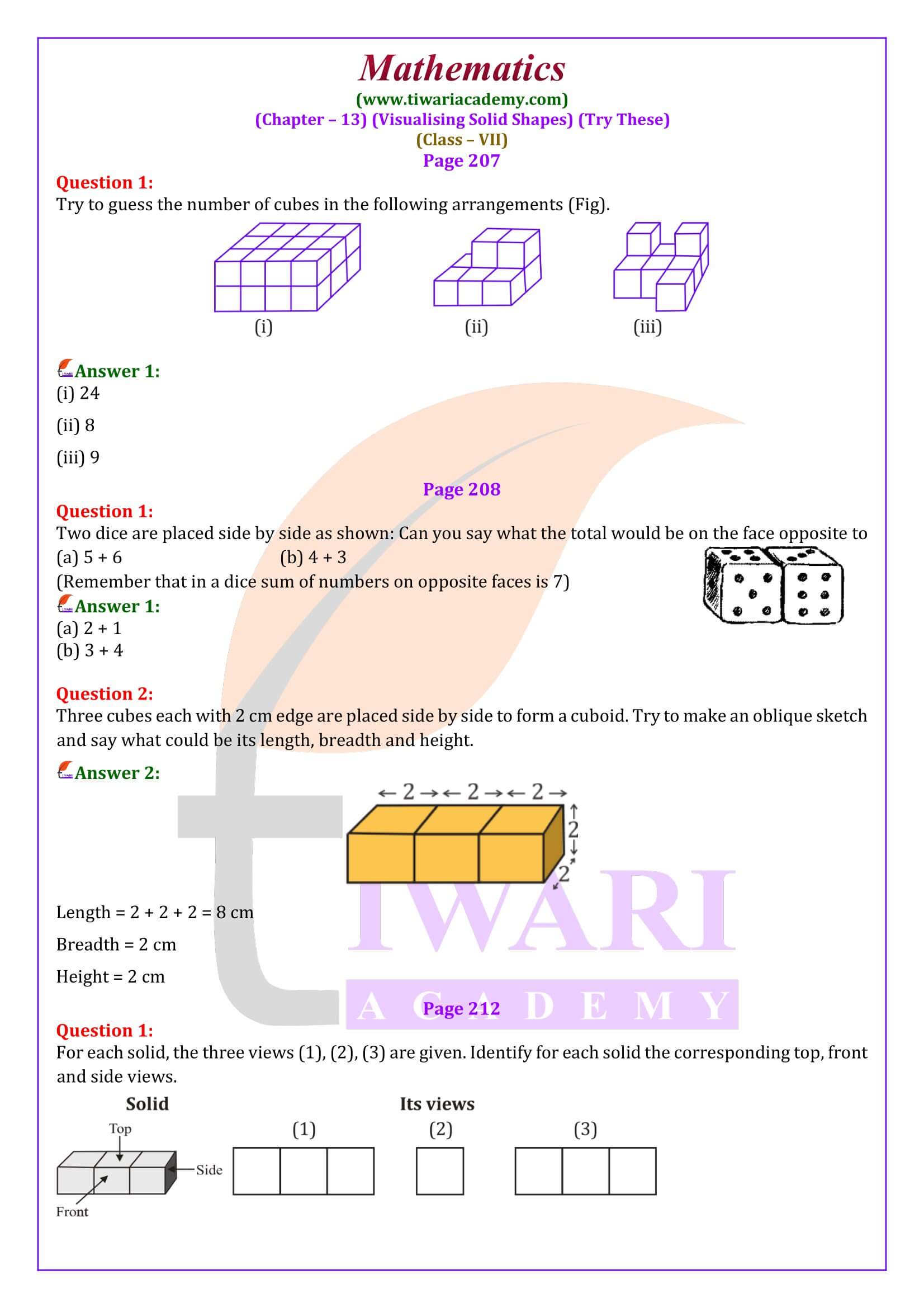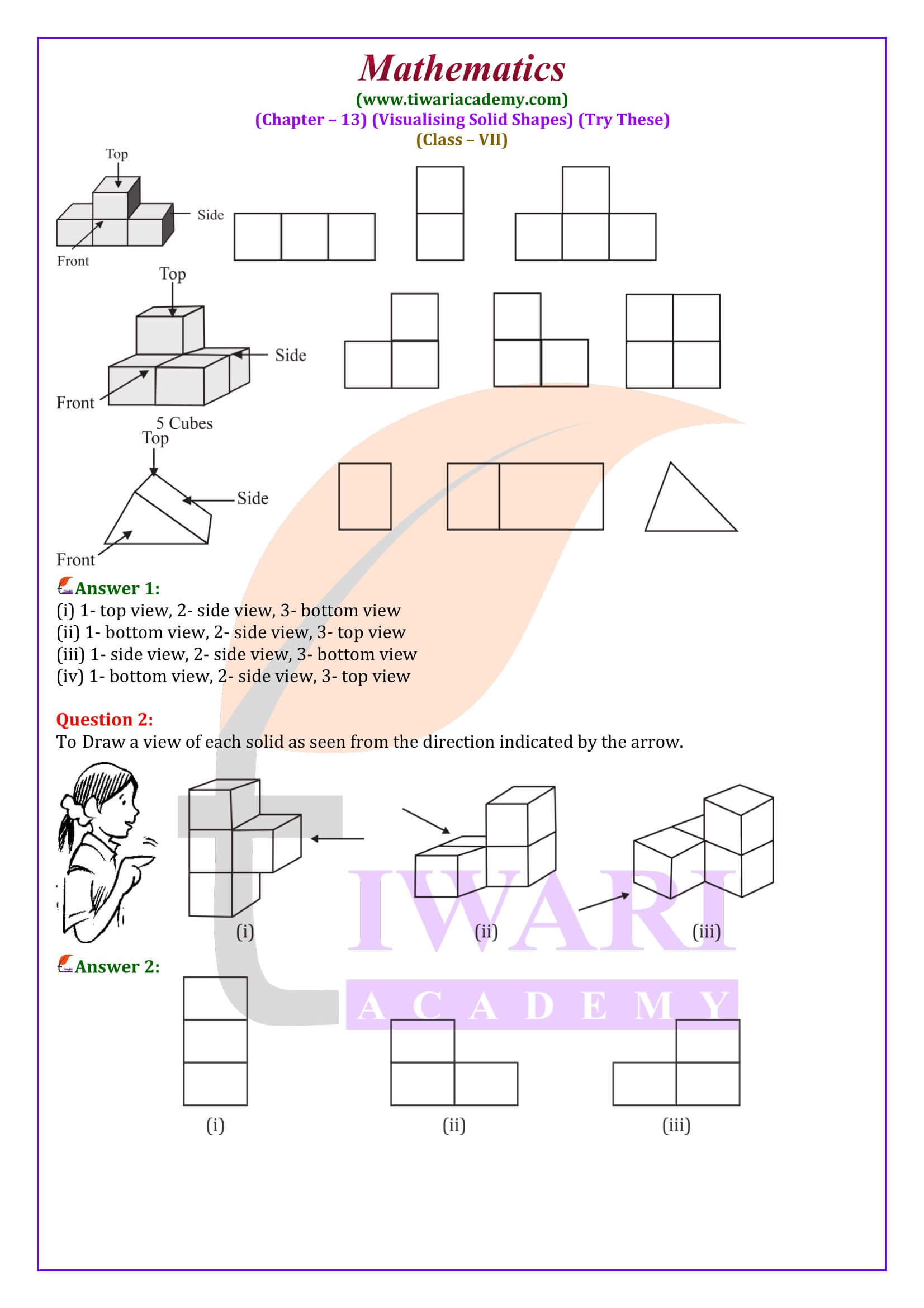NCERT Revised Solutions for Class 7 Mathematics Chapter 13 Visualising Solid Shapes and 7th Maths Chapter 13 Try These Solutions in Hindi and English Medium updated for session 2025-26. NCERT Exercise Solutions for Class 7 Mathematics Chapter 13 Visualising Solid Shapes, offer a comprehensive way to understand 3D geometry. NCERT Class 7th Math chapter 13 focuses on helping students distinguish between mathematical terms 2D and 3D shapes and understand the properties of solid objects like cubes, cuboids and spheres. By using the CBSE Class 7 Maths Chapter 13 NCERT Exercise Solutions PDF, students can explore visualisation techniques and learn how to identify different views of solid shapes. NCERT Book Class 7 Mathematics Chapter 13 Detailed Answers provide step-by-step solutions to the textbook exercises, ensuring clarity on every concept.
NCERT Exercise Solutions for Class 7 Maths Chapter 13 Visualising Solid Shapes
With Visualising Solid Shapes NCERT Mathematics Solutions, students can confidently tackle challenging problems in CBSE and School exams. The Class 7 Maths NCERT Textbook Chapter 13 Exercise Solutions PDF is an excellent resource for revising important topics. Downloading the Visualising Solid Shapes CBSE Class 7 NCERT Book Solutions PDF makes studying convenient, as all exercises are easily accessible. In NCERT Class 7 Maths Chapter 13 Visualising Solid Shapes students will encounter various terms and concepts related to three-dimensional geometry and solid shapes. According to new syllabus and new NCERT books for academic year 2025-26, there are four exercises in chapter 13 of class 7th mathematics. Three-dimensional objects that have length, width and height. Examples include cubes, cuboids, cylinders, cones and spheres.
Class 7 Maths Chapter 13 Solutions in English Medium
Chapter 13 of Class 7 Mathematics, Visualising Solid Shapes, focuses on understanding different views of objects, such as top, front and side views. NCERT Updated Solutions for Visualising Solid Shapes explain these mathematical concepts with well-illustrated examples. The Class 7 CBSE Maths Textbook Chapter 13 Question Answers delve into key topics like vertices, edges and faces of solid figures, ensuring students build a strong foundation in geometry.
Downloading the NCERT Book Class 7th Chapter 13 Exercise Solutions PDF allows students to review and practice anywhere. The Visualising Solid Shapes Class 7 Math Exercise Solutions are designed to improve problem-solving skills by simplifying complex problems. With these resources, Class 7 students can easily understand and retain the concepts. Whether it’s for quick CBSE revision or NCERT detailed study, the Visualising Solid Shapes NCERT Solutions provide all the answers needed to excel in the subject.
Class 7 Maths Chapter 13 Solutions in Hindi Medium
Important Points in Class 7 Maths Chapter 13 for Final Exams
1. 2D vs 3D Shapes: Difference between two-dimensional and three-dimensional figures.
2. Faces, Edges, Vertices: Definitions and examples of solid shapes.
3. Nets of Solids: Creating and identifying nets for 3D objects.
4. Views of Solids: Understanding top, front and side views.
5. Practical Applications: Real-life uses of solid shapes.
| Day | Topic | Activity | Resources |
|---|---|---|---|
| Day 1 | Introduction to Solid Shapes | Read NCERT textbook and make notes | NCERT Class 7 Maths textbook |
| Day 2 | 2D vs 3D Shapes | Practice examples from the textbook | NCERT Solutions PDF |
| Day 3 | Faces, Edges, and Vertices | Draw and label solid shapes | Practice notebook |
| Day 4 | Nets of Solids | Create paper models of 3D shapes | Colored paper and scissors |
| Day 5 | Views of Solids | Practice top, front, and side views | Exercise questions |
| Day 6 | Revision | Review all topics and solve sample problems | NCERT Solutions and mock tests |
| Day 7 | Final Practice | Take a mock test | Sample question papers |
The NCERT Mathematics Solutions Textbook Chapter 13 Class 7 guide students in mastering the basics of 3D geometry through engaging math exercises. Visualising Solid Shapes Solutions PDF includes detailed explanations of all problems, making it an ideal study tool for school exams. The Class 7 Maths NCERT Textbook Chapter 13 Solutions Free Download option ensures that students can access solutions at their convenience. Topics such as drawing nets for 3D shapes and differentiating between 2D and 3D figures are explained step by step.
With the help of Visualising Solid Shapes Class 7 Mathematics NCERT Answers, students can gain confidence in solving geometry-related questions. NCERT Textbook Class 7 Maths CBSE Solutions Chapter 13 ensures a better understanding of visualisation techniques, improving overall performance. Whether it’s a PDF download or a printed resource, Class 7 Math Book Chapter 13 NCERT Simple Solutions provide comprehensive support for students aiming to score high marks.
| Class: 7 | Mathematics |
| Chapter 13: | Visualising Solid Shapes |
| Number of Exercises: | 4 (Four) |
| Content: | NCERT Textbook and Try These Solutions |
| Mode: | Images, Text and Online Videos |
| Academic Year: | Session 2025-26 |
| Medium: | English and Hindi Medium |
Here are the main terms you should learn and understand:
Vertices: The points where the edges of a solid shape meet.
Edges: The line segments where two faces of a solid shape intersect.
Faces: The flat surfaces of a solid shape.
Base: The bottom face of certain solid shapes, like cubes, cuboids, and cones.
Lateral Surface: The curved surface of a cylinder or cone, excluding the base.
Apex: The pointed top of a cone.
Slant Height: The height of the lateral surface of a cone or pyramid.
NCERT Solutions for Class 7 Maths Chapter 13
Class 7 Maths Exercise 13.1, Exercise 13.2, Exercise 13.3 and Exercise 13.4 in English Medium or Prashnavali 13.1, Prashnavali 13.2, Prashnavali 13.3 and Prashnavali 13.4 in Hindi Medium to study online or download in PDF file format free. Class 7 Maths chapter 13 describes about net. Net is a two-dimensional representation of a solid shape that can be folded to form the three-dimensional shape. Download NCERT (https://ncert.nic.in/) Solutions Offline Apps based on updated NCERT Solutions following NCERT Books for session 2025-26.
Important Questions on Class 7 Maths Chapter 13
In how many ways, the cross-section of a solid can be viewed?
Different sections of a solid can be viewed in many ways:
(i) By cutting or slicing, the shape, which would result in the cross-section of the solid.
(ii) By observing a 2-D shadow of a 3-D shape.
(iii) By looking at the shape from different positions-the front-view, the side-view and the top-view.
How many types of sketches of a solid are possible?
Two types of sketches of a solid are possible: (i) An oblique sketch which does not have proportional measurements. (ii) An isometric sketch which is drawn on an isometric dot paper. In this sketch of the solid, the measurements are kept proportional.
What are the parts of a solid?
The corners of a solid shape are called its vertices, the line segments/curves which form its skeleton are its edges and its flat surfaces are its faces.
7 Maths Chapter 13 Solutions
Class 7 Maths Chapter 13 Visualizing Solid Shapes all exercises solutions including proper formulae are given below in updated format. Download NCERT Solutions apps for 2025-26 and Offline contents in PDF form for the new session 2025-26.
Terms to know
Diagonal: A line segment connecting two non-adjacent vertices of a solid shape.
Height/Altitude: The perpendicular distance between the base and the top vertex of a solid shape.
Axis: A line around which a solid shape can be rotated to generate a three-dimensional figure.
Regular Solid: A solid shape with all sides of equal length and all angles of equal measure.
Prism: A solid with two identical and parallel faces (bases) and rectangular or parallelogram-shaped lateral faces.
About NCERT Solutions for Class 7 Maths Chapter 13
In Class 7 Maths Chapter 13, the questions are based on basis of identification of parts of solid (dimensions) figures. We will learn the relations among Edges, Vertices and Faces of solid figures. We will draw the NETS (NETS are 2-D figures, which when folded results in 3-D figures0 for solid figure. Drawing solid figures on the flat surfaces using Oblique Sketches and Isometric Sketches.
1. Oblique Sketch: The sizes of the front faces and its opposite are same and The edges, which are all equal in a cube, appear so in the sketch, though the actual measures of edges are not taken so.
2. Isometric Sketch: An isometric sketch is drawn on an isometric dot paper, a sample of which is given at the end of this book. In an isometric sketch of the solid the measurements kept proportional.
Some other definitions
Cylinder: A solid with two parallel circular bases and a curved lateral surface.
Cone: A solid with a circular base and a curved lateral surface that converges to a single point (apex).
Sphere: A three-dimensional object with all points equidistant from the center point.
Cuboid: A solid with six rectangular faces and all right angles.
Cube: A special type of cuboid with all sides of equal length and all angles of 90 degrees.
Polyhedron: A solid with flat faces, straight edges, and vertices.
Important to Remember:
1. Solid shapes can be drawn on a flat surface (like paper) realistically. We call this 2-D representation of a 3-D solid.
2. Visualizing solid shapes is a very useful skill. You should be able to see ‘hidden’ parts of the solid shape using dots.
3. The corners of a solid shape are called its vertices, the line segments of its skeleton are its edges and its flat surfaces are its faces.
4. Isometric View: A drawing that shows a 3D object as it appears in real life, using dimensions that preserve the proportional relationships.
5. Orthographic View: A set of two-dimensional views (front, top, and side) that represent the three-dimensional object from different angles.
6. Elevation: The view of an object from one side.
7. Plan: The view of an object from the top.
8. Section: A cut or slice made through a solid shape to reveal its internal structure.
Feedback & Suggestions
NCERT Solutions for Class 7 Maths Chapter 13 in Hindi Medium is now available for the current academic session 2025-26 based on latest NCERT Books. Understanding these terms will help you navigate through the concepts of three-dimensional geometry and visualizing solid shapes. Practice drawing, identifying, and analyzing these shapes to reinforce your understanding. NCERT Solutions in Hindi are prepared just because of student’s demand. Please suggest us more to improve website for session 2025-26.
What are NCERT Solutions for Class 7 Maths Chapter 13?
NCERT Solutions for Class 7 Mathematics Chapter 13 Visualising Solid Shapes are a detailed set of answers to all the exercises in this chapter. These solutions provide clarity on concepts like edges, vertices and faces of 3D shapes, helping students distinguish between 2D and 3D figures. Using the Class 7 Maths Textbook Chapter 13 Solutions PDF, students can access step-by-step explanations for all problems. With Visualising Solid Shapes NCERT PDF Solutions, students can build a solid foundation in geometry and improve their problem-solving skills. These NCERT Math solutions are essential for exam preparation and revising key topics efficiently.
How can I access Class 7 Maths Chapter 13 Solutions PDF?
You can easily access the Class 7 Maths Chapter 13 Solutions NCERT PDF by downloading it from reliable educational platforms like Tiwari Academy or NCERT’s official website. These Visualising Solid Shapes NCERT Textbook Solutions are designed to provide comprehensive explanations for all exercise problems. Whether it’s the NCERT Class 7 Maths Textbook Chapter 13 Answers or Visualising Solid Shapes Exercise Solutions, the PDF ensures convenient and CBSE structured learning. With this downloadable resource, students can practice questions anytime, helping them prepare thoroughly for exams and build confidence in solving problems related to solid shapes.
What topics are covered in Visualising Solid Shapes Class 7 NCERT Solutions?
NCERT Complete Solutions for Class 7 Math Chapter 13 cover essential topics like identifying 2D and 3D shapes, understanding vertices, edges and faces and drawing nets for solid figures. With Class 7 NCERT Math Chapter 13 CBSE Question Answers, students can learn to visualise objects from different perspectives, such as top, front and side views. The Visualising Solid Shapes CBSE Class 7 Exercise NCERT Book Solutions also focus on developing spatial understanding and analytical thinking. These solutions provide a step-by-step approach to solving geometry problems, making it easier for students to grasp complex concepts effectively.
Why are Class 7 Maths Chapter 13 NCERT Solutions important for students?
Class 7 Mathematics NCERT Textbook Chapter 13 Solutions are important because they simplify the understanding of solid shapes and their properties. The Visualising Solid Shapes NCERT Explained Solutions guide students through concepts like identifying 3D objects and their views. By practicing with the Class 7 Maths CBSE Chapter 13 Exercise Solutions, students can build strong problem-solving skills and prepare for exams. NCERT Class 7 Mathematics Chapter 13 Solutions PDF allows easy access to all CBSE exercises and answers, making it a convenient resource. These solutions help students excel by providing clear, structured explanations for every problem.
Can I rely on Visualising Solid Shapes Solutions PDF for exam preparation?
Yes, the Visualising Solid Shapes Solutions PDF is an excellent resource for exam preparation. The NCERT Mathematics Textbook Solutions Chapter 13 Class 7 provide detailed answers and explanations for all CBSE exercise problems, helping students build a deep understanding of 3D geometry. The Class 7 Math Chapter 13 Solutions Free Download option ensures students can access the material anytime for revision. By practicing with Visualising Solid Shapes Class 7 NCERT Textbook Answers, students can strengthen their geometry skills and perform well in exams. This PDF is a reliable CBSE guide for mastering Chapter 13 concepts thoroughly.







